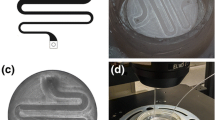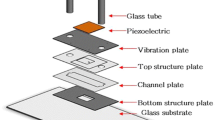Abstract
We present a new technique for fabricating planar patch electrodes in the laboratory. Planar electrodes are micromolded using a micron-sized stream of air to define an aperture in the silicone elastomer, polydimethylsiloxane (PDMS). We have previously demonstrated that planar PDMS electrodes make excellent patch electrodes after surface modification. We demonstrate single-channel measurements of the rSlo channel in Xenopus oocytes and whole-cell measurements in CHO and RBL mammalian cell lines, using planar PDMS electrodes.







Similar content being viewed by others
References
Armstrong CM, Bezanilla F (1977) Inactivation of the sodium channel. II. Gating current experiments. J Gen Physiol 70:567–590
Brüggemann A, George M, Klau M, Beckler M, Steindl J, Behrends JC, Fertig N (2004) Ion channel drug discovery and research: the automated nano-patch-clamp technology. Curr Drug Discov Technol 1:91–96
Diaz L, Meera P, Amigo J, Stefani E, Alvarez O, Toro L, Latorre R (1998) Role of S4 segment in a voltage-dependent calcium-sensitive potassium (hSlo) channel. J Biol Chem 273:32430–32436
Hamill OP, Marty A, Neher E, Sakmann B, Sigworth FJ (1981) Improved patch-clamp techniques for high-resolution current recording from cells and cell-free membrane patches. Pflugers Arch 391:85–100
Hollahan JR, Carlson GL (1970) Hydroxylation of polymethylsiloxane surfaces by oxidizing plasmas. J Appl Polym Sci 14:2499
Hillborg H, Gedde UW (1998) Hydrophobicity recovery of polydimethylsiloxane after exposure to corona discharges. Polymer 39:1991–1998
Kim J, Chaudhury MK, Owen MJ (1999) Hydrophobicity loss and recovery of silicone HV insulation. IEEE Trans Dielect Elect Insul 6:695–702
Kiss L, Bennett PB, Uebele VN, Koblan KS, Kane SA, Neagle B, Schroeder K (2003) High throughput ion-channel pharmacology: planar-array-based voltage clamp. Assay Drug Devel Technol 1:127–135
Klemic, KG, Klemic JF, Reed MA, Sigworth FJ (2002) Micromolded PDMS planar electrode allows patch-clamp electrical recordings from cells. Biosens Bioelect 17:597–604
Lee JN, Park C, Whitesides GM (2003) Solvent compatibility of poly(dimethylsiloxane)-based microfluidic devices Anal Chem 75:6544–6554
Lindau M, Fernandez JM (1986) A patch-clamp study of histamine-secreting cells. J Gen Physiol 88:349–368
Methfessel C, Witzemann V, Takahashi T, Mishina M, Numa S, Sakmann B (1986) Patch clamp measurements on Xenopus laevis oocytes: current through endogenous channels and implanted acetylcholine receptor and sodium channels. Pflugers Arch 407:577–588
Osipchuk Y, Dromaretcky A, Savtchenko A, Yang I, Mathes C, Chuchward P, Kleinschmidt J, Smith-Maxwell C, Blatz A (2001) Whole-cell recordings from new planar patch clamp electrodes (Abstract). Soc Neurosci 27:606.14
Pantoja R, Sigg D, Blunck R, Bezanilla F, Heath JR (2001) Bilayer reconstitution of voltage-dependent ion channels using a microfabricated silicon chip. Biophys J 81:2389–2394
Penner, R (1995) A practical guide to patch clamping. In: Sakmann B, Neher E (eds) Single-channel recording. Plenum, New York, pp 3–30
Schmidt C, Mayer M, Vogel H (2000) A chip-based biosensor for the functional analysis of single ion channels. Angew Chem Int Ed 39:3137–3140
Sigworth FJ, Klemic KG (2002) Patch clamp on a chip. Biophys J 82:2831–2832
Stühmer, W (1998) Electrophysiologic recordings from Xenopus oocytes. Methods Enzymol 293:280–300
Xia Y, Whitesides GM (1998) Soft Lithography. Annu Rev Mater Sci 28:153–184
Xu J, Wang X, Ensign B, Li M, Wu L, Guia A, Xu J (2001) Ion-channel assay technologies: quo vadis? Drug Discov Today 6:1278–1287
Xu J, Guia A, Rothwarf D, Huang M, Sithiphong K, Ouang J, Tao G, Wang X, Wu L (2003) A benchmark study with SealChip planar patch-clamp technology. Assay Drug Devel Technol 1:675–683
Acknowledgements
We thank Yuri Osipchuk (Axon Instruments) for helpful discussions and sharing his idea of using a silver tube to act both as electrical connector and suction port. We also thank Azucena Munden for her help in electrode fabrication, Teresa Giraldez (Yale University) for advice and help with cell culture, and Mark Reed (Yale University) for helpful discussions. This work was supported by NIH grant EB-002020 and a grant from Axon Instruments.
Author information
Authors and Affiliations
Corresponding author
Rights and permissions
About this article
Cite this article
Klemic, K.G., Klemic, J.F. & Sigworth, F.J. An air-molding technique for fabricating PDMS planar patch-clamp electrodes. Pflugers Arch - Eur J Physiol 449, 564–572 (2005). https://doi.org/10.1007/s00424-004-1360-8
Received:
Revised:
Accepted:
Published:
Issue Date:
DOI: https://doi.org/10.1007/s00424-004-1360-8




